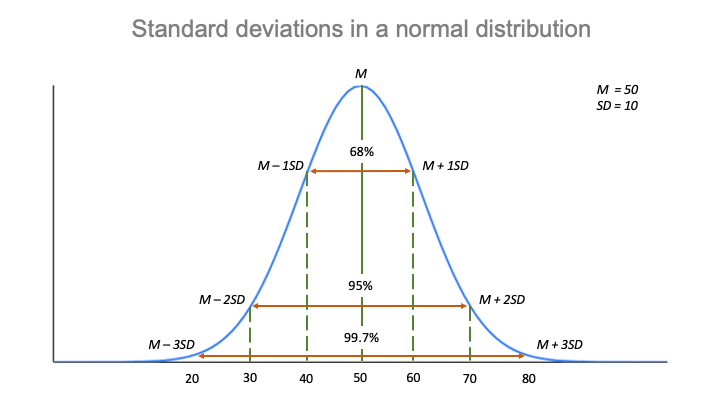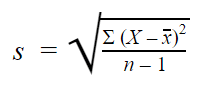What Is The Standard Deviation Of The Data?
Standard Difference | A Step past Step Guide with Formulas
The standard deviation is the boilerplate amount of variability in your dataset. It tells you, on average, how far each value lies from the mean.
A high standard deviation means that values are generally far from the hateful, while a low standard deviation indicates that values are clustered close to the mean.
What does standard difference tell you?
Standard deviation is a useful measure of spread for normal distributions.
In normal distributions, data is symmetrically distributed with no skew. Most values cluster effectually a central region, with values tapering off every bit they get further away from the center. The standard deviation tells yous how spread out from the middle of the distribution your information is on average.
Many scientific variables follow normal distributions, including height, standardized exam scores, or job satisfaction ratings. When you accept the standard deviations of different samples, you can compare their distributions using statistical tests to brand inferences about the larger populations they came from.
The mean (M) ratings are the same for each group – it's the value on the x-axis when the curve is at its height. However, their standard deviations (SD) differ from each other.
The standard divergence reflects the dispersion of the distribution. The curve with the everyman standard departure has a high peak and a small spread, while the bend with the highest standard divergence is more flat and widespread.

The empirical rule
The standard deviation and the mean together can tell you where most of the values in your distribution lie if they follow a normal distribution.
The empirical dominion, or the 68-95-99.7 rule, tells you where your values lie:
- Around 68% of scores are within 1 standard deviation of the mean,
- Around 95% of scores are within 2 standard deviations of the mean,
- Around 99.vii% of scores are inside 3 standard deviations of the mean.
Following the empirical rule:
- Effectually 68% of scores are between 40 and 60.
- Around 95% of scores are between 30 and seventy.
- Around 99.7% of scores are between 20 and 80.

The empirical rule is a quick manner to get an overview of your information and bank check for whatsoever outliers or extreme values that don't follow this pattern.
For non-normal distributions, the standard deviation is a less reliable measure of variability and should be used in combination with other measures like the range or interquartile range.
Standard deviation formulas for populations and samples
Different formulas are used for calculating standard deviations depending on whether you have information from a whole population or a sample.
Population standard deviation
When you have collected data from every member of the population that you're interested in, you can get an exact value for population standard divergence.
The population standard divergence formula looks like this:
| Formula | Explanation |
|---|---|
 |
|
Sample standard deviation
When yous collect data from a sample, the sample standard divergence is used to brand estimates or inferences about the population standard deviation.
The sample standard deviation formula looks like this:
| Formula | Explanation |
|---|---|
 |
|
With samples, we utilise n – 1 in the formula because using n would requite us a biased estimate that consistently underestimates variability. The sample standard difference would tend to be lower than the real standard divergence of the population.
Reducing the sample northward to due north – one makes the standard deviation artificially large, giving y'all a conservative approximate of variability.
While this is not an unbiased guess, information technology is a less biased estimate of standard divergence: information technology is better to overestimate rather than underestimate variability in samples.
Steps for calculating the standard deviation
The standard divergence is usually calculated automatically past whichever software you use for your statistical analysis. Just you tin too summate it by mitt to better understand how the formula works.
At that place are six main steps for finding the standard divergence by manus. We'll use a minor data set of 6 scores to walk through the steps.
| Data set | |||||
|---|---|---|---|---|---|
| 46 | 69 | 32 | 60 | 52 | 41 |
Step ane: Discover the hateful
To find the mean, add upwardly all the scores, then divide them by the number of scores.
| Mean (x̅) |
|---|
| x̅ = (46 + 69 + 32 + sixty + 52 + 41) ÷ 6 = 50 |
Footstep 2: Find each score'southward deviation from the mean
Subtract the mean from each score to get the deviations from the hateful.
Since x̅ = 50, hither we have abroad 50 from each score.
| Score | Deviation from the mean |
|---|---|
| 46 | 46 – fifty = -four |
| 69 | 69 – fifty = 19 |
| 32 | 32 – fifty = -18 |
| sixty | 60 – 50 = ten |
| 52 | 52 – l = 2 |
| 41 | 41 – fifty = -9 |
Step 3: Square each difference from the mean
Multiply each deviation from the mean by itself. This will result in positive numbers.
| Squared deviations from the mean |
|---|
| (-iv)2 = 4 × iv = 16 |
| 19two = 19 × 19 = 361 |
| (-18)two = -18 × -18 = 324 |
| 10two = 10 × ten = 100 |
| 22 = 2 × 2 = 4 |
| (-9)2 = -nine × -nine = 81 |
Footstep 4: Detect the sum of squares
Add upwardly all of the squared deviations. This is called the sum of squares.
| Sum of squares |
|---|
| 16 + 361 + 324 + 100 + 4 + 81 = 886 |
Pace 5: Find the variance
Split the sum of the squares by north – 1 (for a sample) or North (for a population) – this is the variance.
Since nosotros're working with a sample size of 6, nosotros will utilize northward – ane, where n = 6.
| Variance |
|---|
| 886 ÷ (half dozen – 1) = 886 ÷ five = 177.2 |
Footstep six: Find the square root of the variance
To find the standard departure, nosotros take the foursquare root of the variance.
| Standard departure |
|---|
| √177.two = 13.31 |
From learning that SD = 13.31, we can say that each score deviates from the hateful by 13.31 points on average.
Why is standard deviation a useful measure out of variability?
Although there are simpler means to calculate variability, the standard deviation formula weighs unevenly spread out samples more than than evenly spread samples. A higher standard deviation tells you lot that the distribution is not only more spread out, but too more than unevenly spread out.
This means it gives y'all a better thought of your data's variability than simpler measures, such as the mean absolute deviation (MAD).
The MAD is similar to standard divergence but easier to calculate. Beginning, you lot limited each deviation from the mean in accented values past converting them into positive numbers (for example, -three becomes 3). And then, y'all summate the mean of these absolute deviations.
Dissimilar the standard deviation, you don't have to calculate squares or square roots of numbers for the MAD. All the same, for that reason, information technology gives you a less precise measure of variability.
Let's take two samples with the same central tendency simply different amounts of variability. Sample B is more variable than Sample A.
| Values | Mean | Hateful absolute departure | Standard deviation | |
|---|---|---|---|---|
| Sample A | 66, xxx, 40, 64 | 50 | fifteen | 17.viii |
| Sample B | 51, 21, 79, 49 | fifty | 15 | 23.7 |
For samples with equal average deviations from the mean, the MAD tin't differentiate levels of spread. The standard divergence is more precise: information technology is higher for the sample with more than variability in deviations from the mean.
By squaring the differences from the mean, standard deviation reflects uneven dispersion more accurately. This footstep weighs farthermost deviations more than heavily than small deviations.
However, this also makes the standard deviation sensitive to outliers.
Oft asked questions near standard deviation
- What does standard deviation tell y'all?
-
The standard difference is the boilerplate amount of variability in your data set. It tells you, on average, how far each score lies from the mean.
In normal distributions, a high standard departure means that values are by and large far from the mean, while a low standard deviation indicates that values are clustered shut to the mean.
- What is the empirical rule?
-
The empirical rule, or the 68-95-99.7 rule, tells you where most of the values lie in a normal distribution:
- Around 68% of values are within one standard deviation of the hateful.
- Effectually 95% of values are inside ii standard deviations of the mean.
- Around 99.seven% of values are within 3 standard deviations of the mean.
The empirical dominion is a quick way to get an overview of your data and check for any outliers or farthermost values that don't follow this design.
Is this article helpful?
You lot take already voted. Thank you :-) Your vote is saved :-) Processing your vote...
What Is The Standard Deviation Of The Data?,
Source: https://www.scribbr.com/statistics/standard-deviation/
Posted by: denneywinger.blogspot.com


0 Response to "What Is The Standard Deviation Of The Data?"
Post a Comment